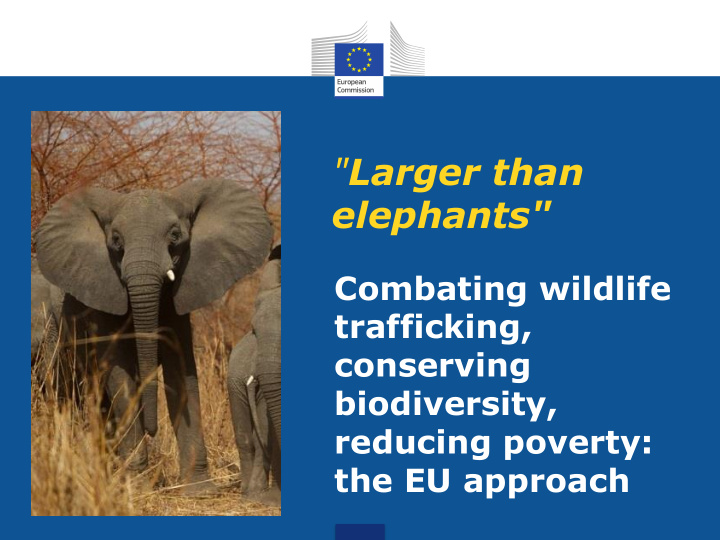



" Larger than elephants" Combating wildlife trafficking, conserving biodiversity, reducing poverty: the EU approach
Biodiversity for Life Flagship Initiative • " Contribute to halting biodiversity loss and reducing poverty by promoting a cross-cutting and innovative approach to fully integrate biodiversity and ecosystem conservation with socio-economic development and poverty eradication ". • Three priority areas, in line with the EU Agenda for Change : 1. Good governance of natural resources 2. Biodiversity for Food security 3. Nature-based solutions towards green economy 4. Wildlife Crisis Window (WCW) • Give more prominence and enhanced profile for biodiversity within the development agenda, thus… increase resources.
EU support to African National Parks Zakouma since 1988 Park W since 2001 Manovo … since 1989 Niokolo-Badiar 1995-2005 Garamba since 2005 Pendjari 1985-1989 Lopé since 1992 Virunga since 1988 Salonga Odzala since 2002 since 1992 Kalahari 1998-2002
EU Context • EuropeAid: third world biggest donor for biodiversity ( € 1.6 billion 2006- 2013) • Capacity building for protected areas management (long experience in Africa) • Integration of biodiversity in forest management, climate change adaptation and mitigation, rural development and food security, marine resources management; • Big poaching peak pressures on wildlife in the 80s • New, stronger pressure on biodiversity in the 2000s: poaching, land-use change, demographic growth, globalisation …
The study: Larger than elephants Identify at the scale of Sub-Saharan Africa the principal threats to wildlife (including animals and plants) and the most appropriate responses for the next 10 years. Not limited to wildlife trafficking, but focused on conservation and sustainable management of wildlife and its linkage with development. Important for the aid programming Credit: Gregoire Dubois Not limited to EU activities but can be a frame for many sources of funding Reviewed and endorsed by a wide array of stakeholders from the conservation community.
Causes Habitat Poaching destruction
Causes Climate Change Credit: Gregoire Dubois
Underlying Drivers • Demography Overpopulation/growth rate Irresistible consumer demand Zambia • Governance & management Poor governance/corruption Weak legislation Civil conflict Current population: 13 million 2100 population: 130 million Low management capacity and budget • Economy / other Poverty/few livelihood alternatives Breakdown of traditions controlling access to land and hunting areas Globalisation Land tenure
Site-level National International Conservation and Stopping the illegal sustainable Institutional killing, trafficking development of 80 strengthening and and demand of Key areas for capacity-building wildlife products conservation Information systems for better decision-making
Planned activities at local level Concentrated in 80 Key Landscapes for Conservation covering ± 300 N.P. Management of protected areas (anti-poaching, ecological monitoring, tourism, finance…) Livelihood improvement around KLCs by development projects (agriculture, energy, etc.) and community-based resource management Sustainable management of biological resources (bushmeat, fuelwood, etc.)
Economic development and conservation The case of Virunga N.P. Supported by EU from 1988 till 2020 Strong pressure for land due to population and available other resources in the park (oil, minerals, wood) Anti-poaching activities (150 rangers killed in the last 20 years) Economic development based on hydropower energy, fisheries, tourism and agroindustry >100,000 jobs created
Planned activities at national level • Policy and institutions Institutional strengthening Land planning and management at the landscape level Law revision and enforcement, combatting corruption Fight against illegal trafficking • Socio-Economy Management of bushmeat resources A solution to fuelwood crisis Alternative revenues
Planned activities at international level Demand Political dialogue with Asian countries Awareness-raising at demand-side Trade regulation Regional cooperation (lessons learned, observatories…) Trafficking Capacity-building of customs, police, justice Support to UN and NGOs (ICCWC, EAGLE…) Credit: Gregoire Dubois
Still to come soon... Strategic approaches to widlife conservation... • Coastal and marine areas of Africa • Latin-America • Asia
Total budget for B4LIFE flagship 2014-2020 Possible EU across several funding instruments or programmes: Trust Fund for Wildlife around 1 billion EUR Conservation ? GPGC - others 10.0% EDF - National 22.3% GPGC - BES 22.3% Latin EDF- Regional America/Asia 21.4% 5.0% EDF - ACP 19.0%
Increasing political uptake Jan 2014: EP Resolution on wildlife crime Feb 2014: Commission Communication on the EU approach against Wildlife Trafficking April 2014: EU on-line consultation and conference – 170 experts, 34 countries, key IOs, >20 NGOs. Summary of contributions to the consultation published in Nov 2014. Feb 2014: London Declaration; Jun 2014: UNEA Resolution; Mar 2015: Kasane Statement. • April 2015: Joint Declaration of EU and AU Commissioners mentions cooperation on illegal wildlife trafficking . Regional and national political dialogues under Art. 8 of the Cotonou Agreement: wildlife conversation and wildlife crime increasingly addressed to tackle both the supply and demand side. July 2015: UNGA Resolution on Illegal Wildlife Trafficking
Toward an Action Plan EU action plan on Wildlife trafficking in preparation by Commission (ENV, DEVCO, HOME, JUST, EEAS…). Based on strong support from stakeholders while the consultation. • DEVCO provides input to this Action Plan on the development aspects, through its 'Larger than Elephants' report. • Roadmap published (Aug 2015) http://ec.europa.eu/smart- regulation/roadmaps/docs/2015_env_087_action_plan_wild_trafficking_en.pdf
Next steps Adoption planned for Discussion in relevant first quarter working groups 2016 (environment, development, justice, Aiming at Council home affairs, external Conclusions still action) under NL Preseidency
of the Envisaged Action Plan focus areas Promoting Strengthening prevention enforcement and Building a strong implementing existing global partnership rules both domestic among source, and globally transit and market countries Integrates inputs from the Strategic Approach to AfricanWildlife Conservation
Questions for feedback • how to further improve donor coordination, both within the EU, with third countries, including in the partner countries? • how to address the link between corruption, wildlife trafficking and poverty more effectively? • how to best target support for demand reduction measures? • how to ensure that cooperation actions against WLT ensures the involvement of local and indigenous communities in wildlife conservation and management?
More information on: • The EU Action Plan against Wildlife Trafficking: http://ec.europa.eu/environment/cites/trafficking _en.htm • The Strategic Approach to African Wildlife Conservation: http://capacity4dev.ec.europa.eu/b4life/documen t/larger-elephants-input-eu-strategic-approach- african-wildlife-conservation-updated-version
Recommend
More recommend